The Polish Volunteer Units in Finland
The first Polish Volunteer units in Finland to be absorbed into the Finnish military were, as has been previously covered, the Polish warships that escaped to Finland. Re-flagged, absorbed into the Merivoimat, their crews sworn in as Finnish Citizens and members of the Merivoimat, the requirements of international law that warships of a foreign belligerent in a neutral port be impounded and their crews interned was bypassed. In this way, Finland added 4 Destroyers, 4 Submarines and a number of smaller warships together with their well-trained crews to the Merivoimat’s naval strength. This strategy, as with that for Polish Air Force aircraft and personnel arriving by air, had been previously discussed and agreed on by both Finland and Poland at the highest political and military levels as a remote contingency measure. At the time these measures were taken, Poland was collapsing under the combined German-Soviet onslaught and neither of Polands “Allies”, Britain or France, were consulted or involved in any way. In the event there was no reaction at all from France, and a very muted one from the UK – the Admiralty’s view was that three Polish destroyers were of no real consequence to the Royal Navy, and their location in the remote Norwegian port of Lyngenfjord and the movement of other Polish warships to Finnish ports was of no relevance whatsoever to the Navy’s war against Germany.
In the same way, we have noted that a number of Polish Airforce aircraft made it to Finland in mid-September. These consisted of twenty-seven of the modern PZL.37 Łoś bombers, 21 P.23 Karas light bombers / reconnaissance aircraft, 36 PZL P.11 fighters, 11 PZL P.7a Fighters and 10 RWD-17 trainers. The Ilmavoimat began to form these aircraft into 4 additional Squadrons – one of the PZL.37’s, one of the P.23’s and two of the PZL P.11 Fighters. The P.7’s and RWD-17’s were assigned to Ilmavoimat training units. The two P.11 Fighter squadrons were used as “second-line” fighters and patrol aircraft. Their performance was insufficient to catch the Soviet bombers but if flown well, they could at least take on the Soviet fighters with a chance – and if they had altitude on the Soviet bombers they could catch them by diving. However, the Polish pilots were also seasoned survivors and they were provided with more modern fighter aircraft as soon as these were available (after which the surviving P.11’s were also relegated to use as advanced trainers), flying these to great effect over the course of the Winter War, as we will see.
The 27 PZL.37 Łoś bombers were formed into a single squadron and immediately assigned to the same bomber group as the Ilmavoimat’s Swedish-built PZL.37 Łoś’s, 12 of which had been delivered and were in service by November 1939. From October 1939 on, the Ilmavoimat began a rapid program modify the Polish aircraft to resemble the Ilamvoimat’s P.37’s – replacing the glazed nose with a solid nose with 4 machine guns and a single 20mm cannon under each wing root in an external blister, adding armour to the pilots position, fitting additional fuel cells into two of the wing bombbays, eliminating the Radio Operator / Ventral Gunner position, removing the ventral gun and upgrading the rear gun position to two machineguns. By the outbreak of the Winter War, some aircraft had had modificatins completed, some had not. The remaining squadron of P.23’s would be used primarily in an observation and reconnaissance role in the Winter War, flying in support of the 2 Polish Volunteer Divisions that would be formed from the Polish soldiers evacuated to Finland from Latvia and Lithuania.
The political ins and outs and ramifications of the formation of the Polish volunteer units in Finland will be covered in detail in a later Post. In this Post we will concentrate on the formation of the Polish volunteer units and their organisation and equipping.
Of the 30,000 Poles who had been evacuated, some 5,000 were either suffering from injuries, had no prior military experience or were otherwise considered unfit for service or (very few) they didn’t volunteer. Almost all of these men (and women) would take up positions working in Finnish factories or on Finnish farms, where they would make an ongoing and valuable contribution through the war years. Many would end up remaining in Finland after the end of WW2. Of the remaining 25,000, some 2,000 men were members of the Polish Air Force and were assigned to newly formed squadrons within the Ilmavoimat. The remaining men were formed into a Polish Corps within the Maavoimat. The Corps was structured on the Maavoimat model of self-sufficient Heavy Brigade-sized battle groups loosely structured within a Divisional organisation. Over the last half of October and most of November, further numbers of Poles managed to cross the borders into Latvia and Lithuania and once there, were moved north via a Finnish-managed clandestine escape network over roads to Estonia from where they were shipped across to Finland. An additional 7,500 Poles escaped via this network, and more would continue to trickle through up until June 1940. These men would be added to the strength of the Polish Corps.
The Corps was commanded by Lt-Gen. Wladyslaw Anders, the senior Polish Officer in Finland. Major units and commanders included:
Polish Corps Commander: Lt-Gen. Wladyslaw Anders
Polish Corps Deputy Commander: Lt. Gen Zygmunt Bohusz-Szyszko
Polish Corps Chief of Staff: Col. Kazimerz Wisniowski
Polish Corps Engineers: Col. J. Sochocki
Polish Corps Artillery: Maj. Gen R. Odierzynski
663 Polish Air Force Observation Squadron (21 P.23 Karas reconnaisance aircraft)
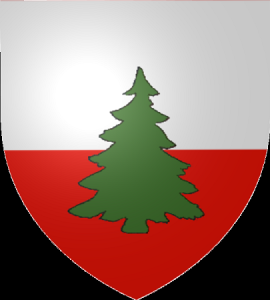
Emblem of the 3rd Carpathian Division (3 Dywizja Strzelców Karpackich), worn as a shoulder patch and painted on vehicles
3rd Carpathian Division (3 Dywizja Strzelców Karpackich): Commander – Maj-General Bronislaw Duch
Divisional Artillery: Col. K. Zabkowski (9 Polish Heavy Artillery Regiment – Mixed), 13 Polish Artillery Regiment, 8 Polish Anti-Aircraft Artillery Regiment)
25 Wielkopolski Recon Battalion
1st Polish Armoured Brigade Commander – Col. Walenty Peszek
(1 Polish Armored Cavalry Battalion, 4 Polish Armored Battalion, 6 Lwowski Armored Battalion, 10 Polish Artillery Regiment, 9 Polish Field Troop – Engineers, Logistical and Support units)
2nd Carpathian Rifle Brigade (2 Brygada Strzelców Karpackich): Commander – Col Roman Szymanski
(4, 5 and 6 Carpathian Rifle Battalions, 11 Polish Artillery Regiment, Logistical and Support units)
3rd Carpathian Rifle Brigade Commander – Lt.-Col G. Lowezowski
(7, 8 and 9 Carpathian Rifle Battalions, 12 Polish Artillery Regiment, Logistical and Support units)
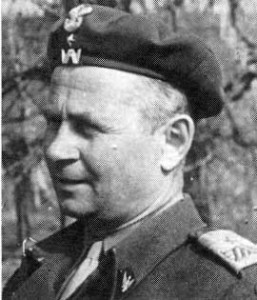
Bolesław Bronisław Duch (1885–1980)
Bolesław Bronisław Duch (1885–1980). Polish Army Major General, Duch served during WWI in the Polish Legion. After Poland regained independence, he served in the Polish Army. In 1935-1938 he commanded the 73rd Infantry Regiment. At the outbreak of WW2 he became the de-facto commander of the 39th Reserve Infantry Division after it’s CO, General Brunon Olbrycht became too ill to command. After Poland was overrun by Germany and the Soviet Union in September 1939, Duch managed to evade capture and escaped via Lithuania to Finland, where he was appointed commander of the 3rd Carpathian Infantry Division, a position he would hold for the remainder of WW2 (Duch would continue to command the 3rd Carpathian Division until 1950, when he retired).
Following the end of the Winter War in late 1940, Duch and the 3rd Carpathian Division would be shipped to the UK and then to the Middle East where they would fight with the British Army. They returned to Finland in late 1943, going on to play an important role in the Finnish-led invasion of Estonia in early 1944. The 3rd Carpathian would fight their way back into Poland in late 1944 and would once more fight the Russians as well as the Germans.
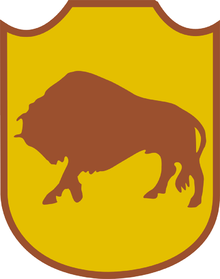
Emblem of the 5th Kresowa Division (5 Kresowa Dywizja Piechoty), worn as a shoulder patch and painted on vehicles
5th Kresowa Division (5 Kresowa Dywizja Piechoty) Commander: Maj-General Nikodem Sulik
Divsional Artillery – Col. J. Orski (7 Polish Horse Artillery Regiment, 78 Medium Artillery Regiment, 5 Kresowa AA Regiment)
15th Poznań Uhlans Regiment (15 Pułk Ułanów Poznańskich): Commander: LtCol. Zbigniew Kiedacz
4th Wolynska Infantry Brigade: Commander: Lt. Col. W Stoczkowski
(10, 11 and 12 Wolynska Rifle Battalions, 2 Kresowa Field Artillery Regiment, 4 Kresowa Anti-Tank Battalion, 4 Kresowa Field Company – Engineers, Logistical and Support units)
5th Wilenska Infantry Brigade – Commander: Col. Wincenty Kurek
(13, 15 and 15 Wilenska Rifle Battalions, 5 Wilenska Field Artillery Regiment, 5 Wilenska Anti-Tank Battalion, 5 Kresowa Polish Field Company – Engineers, Logistical and Support units)
6th Lwoski Infantry Brigade Commander: Col. Witold Nowina-Sawicki
(16, 17 and 18 Lwowski Rifle Battalions, 23 Field Artillery Regiment, 5 Kresowa Anti-Tank Battalion, 6 Kresowa Field Company – Engineers, Logistical and Support units)
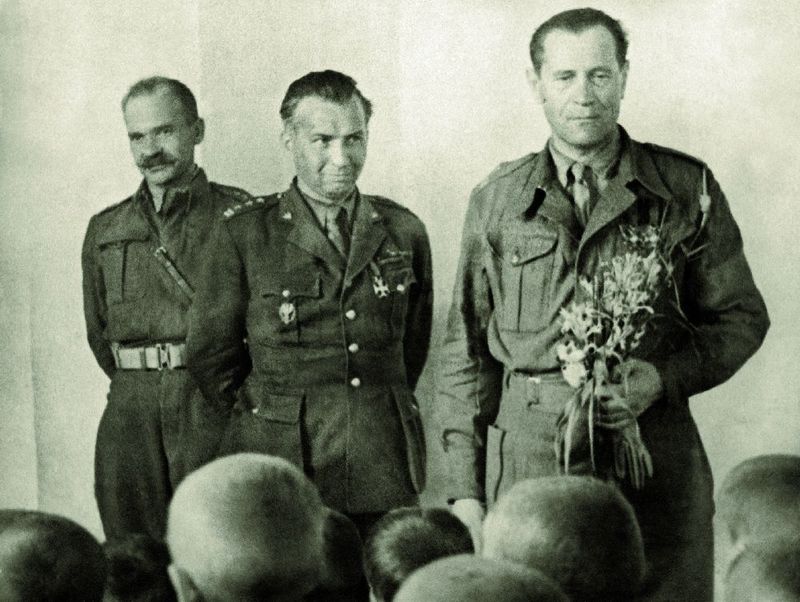
Lt. Gen Zygmunt Bohusz-Szyszko, L. Okulicki I, Maj-General Nikodem Sulik, CO of the 5th Kresowa Division (5 Kresowa Dywizja Piechoty)
Formation and Training of the Polish Corps (Maavoimat) from the Polish Volunteer Units in Finland
The rescued Polish soldiers were made up in many cases of entire units that had crossed the borders into Latvia and Lithuania to escape the Germans and the Soviets, as well as many who had successfully escaped while the occupation forces were still moving in to Poland. Many officers and NCO’s had also escaped either with their men or independently, and the Polish Army was fortunate in that many of these officers were excellent material, well-trained and capable. Many of them had also now had experience fighting the Germans and the Maavoimat took advantage of their experience to conduct in-depth debriefing sessions, the results of which were distributed throughout the Maavoimat.
The Maavoimat officers assigned to work with the Poles moved rapidly, using the Polish Officers and NCO’s to carry out the detailed organizational work necessary to select and allocate men to units as they were formed. Generally, the Poles were structured into units styled after the Maavoimat’s organizational structure, requiring some rapid adaptation by the Poles. There were language and communication difficulties, with most of the communication being carried out in French, English or German – the languages common to both sides. The Poles had escaped without any weapons and the issuing of these, together with winter military clothing and equipment was the first priority. In this, the Maavoimat fell back on their stockpiles of reserve rifles, largely the old Mosin-Nagant rifles that were being replaced within the Maavoimat by the new Lahti-Salaranta SLR 7.62mm. Enough of these had entered service that there were more than enough rifles with which to equip the Poles.
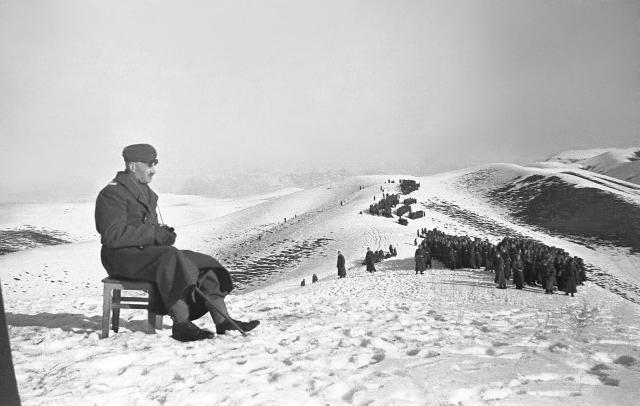
General Władysław Anders, Commander, Polish Corps (Maavoimat) watching exercising Polish troops. Northern Finland: January 1940
Likewise sufficient machineguns, mortars, anti-tank guns and artillery to equip the Polish units were cobbled together from older equipment and “war reserve” stockpiles that the Maavoimat had retained in storage for emergency use. Fortunately, there was enough of the older (more or less obsolete) material available to fully equip the two Polish Divisions, but much of the artillery was equipped with the old guns the Finns had been retiring, the rest of the equipment was similar material, although the anti-tank guns were relatively new – almost all of them were the Bofors 37mm, supplemented with the Lahti 20mm Anti-tank Rifle.
The Maavoimat strung together a series of intense training courses for the Poles which were started in November and which ended up running well into the early weeks of the Winter War. Still, this also allowed for war material to be shipped into Finland from overseas and the end result was that by the time thePolish Corps entered battle, they had experienced two and a half months of Maavoimat training and were a far more combat effective force than they had been when they arrived in Finland. The Polish Corps would move up to the front in early February 1940, taking part in the last great defensive battles on the Karelian Isthmus and then in the Spring Offensive on the Isthmus that shattered the Red Army and took the Maavoimat to the suburbs of Leningrad. They would acquit themselves in battle with distinction.
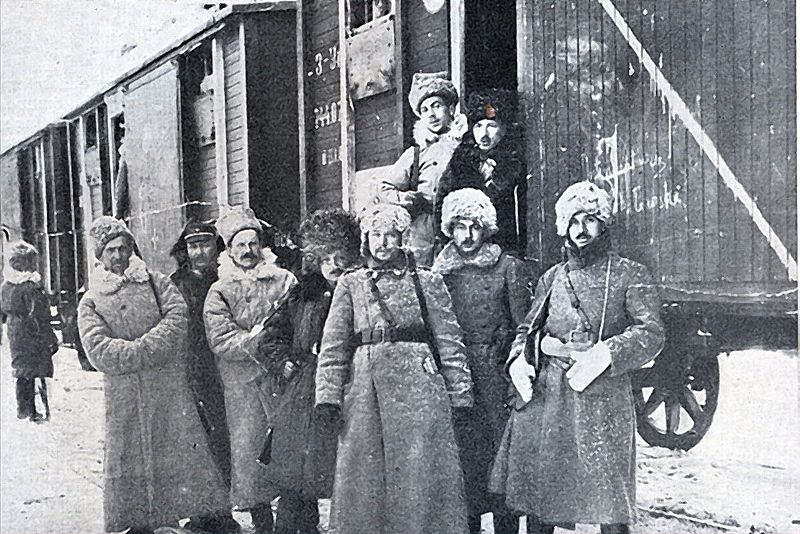
Polish Soldiers of the Polish Corps 5th Kresowa Division moving up to the front after completion of Maavoimat Training, early February 1940
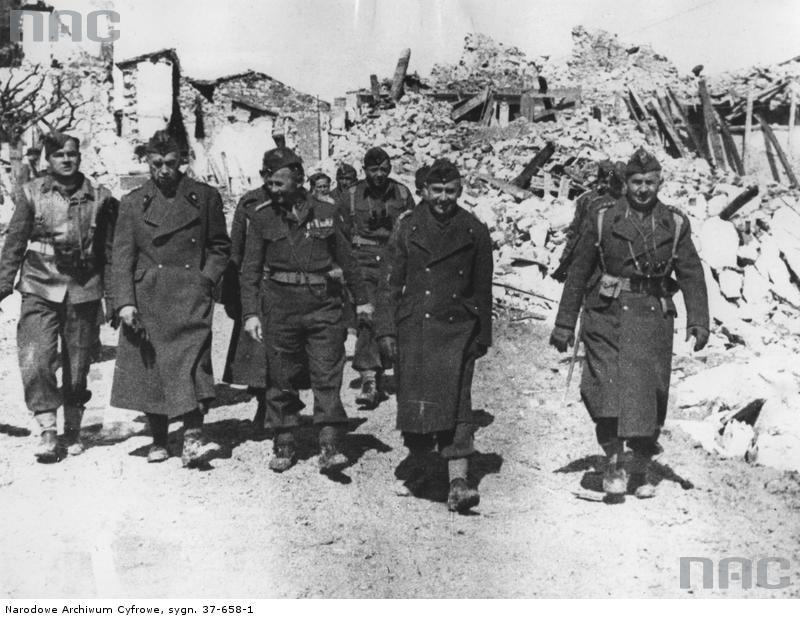
Gen. Kazimierz Sosnkowski, Gen. Bronisław Duch, Gen. Stanisław Kopański, Col Walenty Peszek (CO, 1st Polish Armoured Brigade – Outskirts of Leningrad, July 1940. Polish Army Divisions fought alongside the Maavoimat through both the Winter War and the Continuation War (the name the Finns came to use for the period from April 1994 through to the end of WW2 where they again fought in WW2, albeit for different reasons to the Winter War).
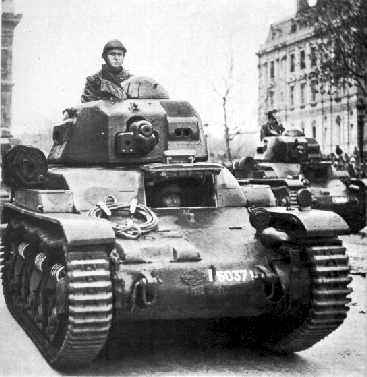
French-supplied Renault R-35 tanks of the 1st Polish Armoured Regiment roll through Viipuri prior to moving to the front – May 1940.
Over the following months, as foreign aid arrived in Finland, new weapons and equipment became available and were issued to units with older equipment or to new units beings set up. With foreign volunteer units arriving almost weekly, it was a major challenge for the Finnish military to ensure enough weapons and ammunition were available.
The Fall of Poland did mean however that some equipment that had been prepared for shipment to Poland via Romania (from France and from the UK) was now made available to the Polish Forces in Finland. This included a shipment of 50 Renault R35 tanks that had been intended for Poland but which, after the Fall of Poland and the Soviet attack on Finland, were shipped to Finland. They were used to equip the 6 Lwowski Armoured Battalion of the 1st Polish Armoured Regiment (1 Pulk Pancerny), commanded by Col. Walenty Peszek. A further 50 Renault R40 Tanks received at the same time would equip the 4 Polish Armoured Battalion while 1 Polish Armoured Cavalry Battalion was equipped with a single shipment of 60 Panhard 178 Armoured Cars.
France had been preparing to ship more tanks, armoured cars, artillery and aircraft to Finland but with the Fall of France, this equipment was lost, largely in transit within France or on French wharves awaiting loading. Large amounts of ammunition were also lost in this way.
US General George Patton and Polish Army General Anders review Polish troops in the Middle East in 1943. Late in 1943, these troops would be shipped to Finland in preparation for the surprise Finnish offensive on the Germans in April 1944. General Anders would again return to Finland with an enlarged Polish Corps, this time equipped by the Americans and British. General Patton would command the combined British/American Corps that fought with the Maavoimat and the Polish Army. Released from British/American political control and now under the command of Marshal Mannerheim, Patton would be given his head. Under the overall command of Marshal Mannerheim, Patton, Anders and the Finnish Army’s Kenraaliluutnantti Karl Lennart Oesch made a truly terrifying triumvirate of military commanders – reporter Virginia Cowles in a memorable article late in the war would call them “Junkyard Pitbulls let off the leash!”
And in a little known twist to the war, Italian ships would also carry Polish soldiers from Hungary to Finland.
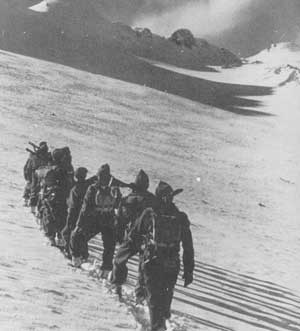
Spring Patrol: Polish troops on the move, Kola Peninsula, Spring 1940
The transfer of Polish soldiers from Hungary to Finland is an almost unknown facet of the Winter War and WW2 that had its origins in the friendly relationship between Poland and Hungary on the one hand, and Finland and Hungary on the other. As Poland collapsed in the face of the joint Nazi-Soviet attack, many Polish soldiers and airmen escaped across the borders into Romania and Hungary together with their weapons and equipment.
The Polish-government-in-exile had originally wanted these men sent to France, but the Machiavellian machinations of the Germans, who did not want France receiving additional soldiers, resulted in the Hungarians transferring these men through Austria to Italy where they were embarked on Italian passenger ships and sent to Finland as a condition of their release. Their equipment was shipped with them and in this way, Finland would acquire some 20,000 additional Polish troops, some of whom would be used to replace casualties in the two existing Polish Divisions which had been formed in Finland.
Others would form an additional Regimental-sized Battle Group which would be used in the capture of Murmansk and the clearing of the Kola Peninsula. The photo shows Polish troops on the move on the Kola Peninsula, searching for Soviet remnants after the taking of Murmansk in Spring 1940.
Further Polish Volunteers Units in Finland – with the Ilmavoimat
Somewhat incidentally, Finland’s strength and capabilities in the air would be augmented greatly by Polish Volunteers for the Ilmavoimat through the Winter War, especially in the last months of the War from June to September 1940. In part, Finland benefited from the pre-war agreements with Poland whereby each country agreed to act as a refuge for the other’s armed foirces in the event of war and if possible. The rescue by the Finns of many thousands of Polish military personnel from Latvia and Lithuania had strengthened this relationship, and that so many of these Poles volunteered to fight for Finland against the USSR further stregthened the mutual regard and feelings of gratitude and respect.
After the collapse of France in May 1940, a large part of the Polish Air Force contingent in France was withdrawn or escaped to the United Kingdom. However, the RAF Air Staff were not willing to accept the independence and sovereignty of Polish Air Force personnel. Air Marshal Sir Hugh Dowding later admitted he had been “a little doubtful” at first about the Polish airmen. The British government informed General Sikorski that at the end of the war, Poland would be charged for all costs involved in maintaining Polish forces in Britain. Plans for the airmen greatly disappointed them: they would only be allowed to join the Royal Air Force Volunteer Reserve, wear British uniforms, fly British flags and they would be required to take two oaths, one to the Polish government and the other to King George VI of the United Kingdom; each officer was required to have a British counterpart, and all Polish pilots were to begin with the rank of “pilot officer”, the lowest rank for a commissioned officer in the RAF. Only after posting would anyone be promoted to a higher grade. Because of that, the majority of the Polish pilots, much more experienced than their RAF counterparts, had to wait in training centres, learning English Command procedures and language, while the RAF suffered heavy losses due to lack of experienced pilots.
This obviously did not go down well with either the Polish Airmen, General Sikorski or the Polish-government-in-exile. Thus, in discussions that were ongoing between Finland and the Polish-government-in-exile, when Finland asked for help from the Poles to provide personnel for polish volunteer units in Finland for the additional aircraft they were bringing into service, and offering equivalent ranks in the Ilmavoimat, together with the formation of 100% Polish squadrons flying under the Polish Flag, the Polish-government-in-exile was quick to agree. Personnel for four squadrons were formed up and moved to Finland in late June 1940. Equipped with aircraft by the Ilmavoimat that had been purchased from the USA, the Polish squadrons quickly became effective. As with their countrymen already in Finland, it was found that there flying skills were well-developed from the Invasion of Poland and their time in France and the Polish pilots were regarded as fearless and sometimes bordering on reckless. In other words, very similar to the Finns. Such was the success of these units that the Finns requested more volunteers, but by this stage the RAF, desperately short of personnel and now impressed by the performance of the Polish airmen they had slowly accepted, refused permission.
However, the RAF would still experience some communications problems…..
 Copyright secured by Digiprove © 2013 Alternative Finland
Copyright secured by Digiprove © 2013 Alternative Finland


3 Responses to The Polish Volunteer Units in Finland